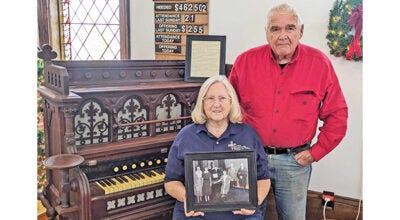The History Center at Courthouse Square
Published 6:02 pm Thursday, January 30, 2014

The 1839 Berrien County Courthouse, the only original county courthouse still standing in Michigan. (Photo courtesy of the Berrien County Historical Association)
BERRIEN SPRINGS—The State of Michigan celebrated its 177th birthday last Sunday, and Berrien Springs is among the few towns around the state that can claim a “living” connection to that anniversary.
“On Jan. 26, 1837, Michigan was granted statehood, and just one month later, Berrien Springs was chosen as Berrien County’s county seat because of the town’s central location,” said Kathy Cyr, executive director of the History Center at Courthouse Square. “That same year, construction on the Berrien County Courthouse began, with the building opening for use in 1839.”
That courthouse, designed in the Greek Revival style by Massachusetts architect Gilbert Avery, still stands today at 313 N. Cass St., making it Michigan’s oldest extant courthouse. Included on the National Register of Historic Places, it is, in fact, the State’s only remaining original courthouse.
Open year-round and with free admission to the public, the History Center at Courthouse Square provides visitors with an opportunity to step back into Michigan’s long and varied history via a complex of original buildings, museum exhibits, special programs, archives, a publications series and a museum store.
“We can do guided tours by appointment, or people can just come and do a self-guided tour with our walking tour brochure,” said Robert Myers, curator of the History Center. “Visitors typically spend an hour to an hour-and-a half here.”
Winter hours are 9 a.m. to 5 p.m., Monday through Friday. The center is open to the public on summer Saturdays as well. More information can be found at www.berrienhistory.org.
While the 1839 Courthouse is the centerpiece of the complex, visitors will also see the original, brick Italianate sheriff’s residence and county office buildings, and the footprint of the original county jail, all dating from the 1870s. A log cabin dating from 1830 and a replica of a forge are also located on the property.
The lower level of the sheriff’s residence houses the museum store and the refurbished sheriff’s office. Next to the residence is the footprint of the jail.
“The jail was torn down in 1916,” Myers said. “But, when the owner tore it down, the foundation was left intact. So, about 15 years ago, we built an outline of the building and a couple of the cells because everybody wanted to know about it. If we are able to raise enough money, we would like to rebuild the jail.”
The lower level of the Courthouse offers visitors a number of exhibits from which they can learn about various periods of Michigan’s history.
Beginning with an exhibit on the ways that glaciers shaped Michigan’s topography, the museum takes guests through the period of early humans and into the era when Native American tribes, such as the Miami and Potawat-omie, called Michigan their home. The museum also chronicles the arrival and activities of French fur traders and missionaries.
The museum also houses exhibits with artifacts that will help visitors to understand Berrien County’s role in national and global events, such as the Civil War and World War I.
It also offers insights into various industries that have supported growth in Berrien County over the years, including the timber trade, the orchard and fruit trade, the railroads and shipping on the St. Joseph River and Lake Michigan.
Other exhibits examine aspects of history that are unique to Berrien County, including the House of David and the Marxochime Colony, a factory complex in New Troy that manufactured a wide array of unusual instruments from 1927 until 1972.
On the second floor of the Courthouse, visitors will find the fully-furnished courtroom where county cases were heard from 1839 until 1894, when the county seat was relocated to St. Joseph.
“This is where we hold mock trials for school groups when they come to visit,” Myers said. “We also use it for special programs in June and July. We’ve done programs on shipwrecks, clothing history, aviation history, all sorts of things. It’s sort of our meeting hall, if you will.”
With 32 years of his own history at the Berrien County Historical Association, Myers has developed a wide variety of programs and products designed to educate Berrien County’s residents, including a series of books that are available in the museum store. A new book, “Greetings from Three Oaks,” will come out in March.
“Bob has designed lot of educational programs, and he can do them on site, or he can come to your classroom, or get on your tour bus and talk about the area,” Cyr said. “He also does evening programs for people who want to learn how to research the histories of their houses.”
Myers also serves as the tour planner and guide for the History Center’s tour series. This spring, the tour is “America’s Architect: Frank Lloyd Wright,” running from May 18 through 20.
Tour stops include Taliesin, Frank Lloyd Wright’s home and studio in Spring Green, Wis.; the First Unitarian Meeting House in Madison, Wis.; the Frank Lloyd Wright Home and Studio in Oak Park, Ill.; and the Frederick C. Robie House in Chicago, Ill. The fee is $599 for History Center members and $649 for non-members. Included in that is all transportation, lodging, breakfasts and dinners, guide services, all admissions, taxes and gratuities. More information can be obtained via email at bcha@berrienhistory.org or by phone at (269) 471-1202.
“One retired couple told me last year, ‘All we have to do is pay our money and get on the bus, and everything is taken care of, and it’s wonderful,’” Cyr said of the popular history tours.





